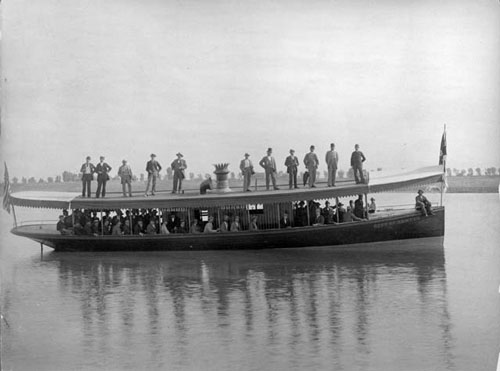

In 1861, Sloan’s Lake literally sprung from the earth. Thomas Sloan, a pioneer farmer, was digging a new well on land that he did not realize belonged to another. The new well, which had tapped an aquifer, quickly overflowed. As the well gushed and the water spread, news of it did as well. Native Americans and citizens of a young Denver watched as Farmer Sloan’s well created a 200-acre lake. From that day forward, Denver and the surrounding communities would head to the lake for picnics, boating, swimming and other leisurely pursuits. The lake also provided ice, cut in the winter months and stored, for Denver and Highlands residents.
While many businessmen attempted to prosper with the construction of resorts and hotels surrounding the lake, the 1891 opening of the Manhattan Beach Club was the first true success. The Manhattan Beach Company provided distractions the likes of which Denver had not seen. They shipped in sand to create a beach, planted 10,000 trees and shrubs and developed formal flower gardens. The Victorian rage of animal menageries saw no limit within the beach club’s grounds. Deliveries of ostriches, bears, buffalo, and seals were not uncommon. Attractions included a roller coaster, a Ferris wheel, contortionists, gypsies, Eskimos, fireworks and baseball games. The result was a popular family destination, despite the distance from Denver.
In 1908, Manhattan Beach Club was burned to the ground, a common occurrence at the turn of the century. The smoldering ash was all that remained of the legendary park and its marvelous entertainments. The citizens of Denver were saddened by the devastating loss.

1909, the developer of nearby Lakeside Amusement Park opened Luna Park on the Manhattan Beach Club grounds, but the competition from Lakeside to the west and Elitch Gardens to the east was too great. In an effort to entice customers, the park began giving away amusements and food. Unfortunately, this attracted the “wrong” element from nearby saloons and the “respectable” citizens turned away from Luna Park. By 1914, the park was officially closed. The area continued to deteriorate and became an untended swampland until 1936 when it was penciled to be a city park as a WPA project. Sloan’s Lake is Denver’s second largest park, with City Park holding that distinguished title.
The area is now a vibrant picnicking and recreation destination for residents of Northwest Denver and the Sloan’s Lake neighborhoods.Numerous trails, bike paths, and green space allows for a relaxing afternoon.
Throughout the years, the Sloan’s Lake neighborhood has held its own in popularity. The architecture is predominantly 1920’s bungalows with the occasional Victorian and Four Square (Denver Square) found.
For more information on the Sloan’s Lake neighborhood and available real estate in the Mile High City, please contact Vintage Homes of Denver.
Copyright © 2013 Vintage Homes of Denver
Real Estate Website Design by High Elevation